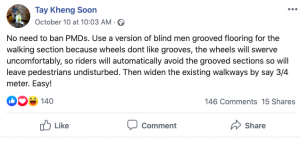Singapore—Adjunct Professor at the National Department of Architecture at the National University of Singapore (NUS) Tay Kheng Soon may have solved the Personal Mobility Device PMD problem on the country’s footpaths.
Accidents have happened when people using PMDs have collided into pedestrians while operating their devices on footpaths, resulting in some serious consequences, and even one fatality. These accidents have caused a number citizens to raise a clamour against their usage, which the government has taken seriously.
However, in the veteran architect’s own words, the solution is “Easy!”
His answer: placing grooves on the pedestrian part of a walkway, leaving it free for people on foot, since wheels do not do well in grooved surfaces, and therefore the people using PMDs would avoid these areas, thus eliminating the chance that collisions would occur.

“No need to ban PMDs. Use a version of blind men grooved flooring for the walking section because wheels don’t like grooves, the wheels will swerve uncomfortably, so riders will automatically avoid the grooved sections so will leave pedestrians undisturbed. Then widen the existing walkways by say 3/4 meter. Easy!,” he wrote on his Facebook wall on October 9.
In a comment to his post he explained his concept further, saying that “the grooves have to be longitudinal along the line of travel to be a deterrent” to PMD users.
Mr Tay’s post was presumably in response to a speech in Parliament made by Senior Minister of State for Transport Janil Puthucheary two days earlier. The minister had brought up the possibility of banning the use of personal mobility devices (PMDs) should the behavior of riders remain unchanged, citing the safety of pedestrians as the main concern.
Dr Janil mentioned how the death of a 65-year-old woman after a PMD collided with her, as well as the growing number of accidents due to more and more people using PMDs.
He said, “Many wish for footpaths to be safe for pedestrians again. We share this wish too.
We are determined to improve footpath safety back to levels before PMDs were allowed onto footpaths.”
The architect had apparently thought the matter through, adding as a comment to his original post, a suggestion for how exactly this can be done.
He wrote, “Start research on the size and depth and spacing of the grooves to get the exact dimensions that suit walking but makes it hard to ride narrow wheels on. Then invest in a factory in Batam or Johore to make these tiles to glue onto existing footpaths so as not to need to hack them up. Then pass a regulation that fat tire wheels are not to be imported.”
Professor Tay, however, also added that future paths need to be wider in order to accommodate all types of users. “We have to adapt to existing situations but for new developments by all means provide wider paths within our natural space limitations.”
In his speech in Parliament, Dr Janil made an appeal for PMD users to be cautious in the use of their devices. “In the meantime, we strongly urge PMD users to be extra responsible and mindful of others. If their behaviour does not improve, we may have no choice but to ban their usage completely from Singapore. This would be a loss.” -/TISG
Read related: Possible banning of PMDs if rider behavior does not improve—Janil Puthucheary
Possible complete ban on PMDs if rider behaviour does not improve—Janil Puthucheary

